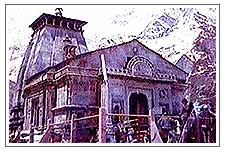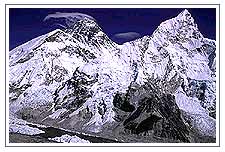The Himalyas
are a continuous source of inspiration as well as life itself. These
mountains defy description, not only because of their grandeur and
expansiveness, but also because of the overpowering role played by them in
the story of the world. The best way to introduce them would perhaps be with
a story.
Once upon a time, there lived a king called "Milinda". He asked a
sage called "Nagasena" about the Himalyas. The sage replied in a
single verse which when translated reads:
"The Himalya, the king of the mountains, five and thousand league in
extent at the circumference, with its ranges or eight hundred and forty
thousand peaks, the source of five hundred rivers, the dwelling place of
multitudes of mighty creatures, the producer of manifold perfumes, enriched
with hundreds of magical drugs, it is seen to rise aloft like a cloud in the
centre of the earth." In fact, a text called the Sama Veda (Sam Veda)
does describe the mountain ranges to be the centre of the earth.
To the sage's description may be added that these ranges are the
youngest in India and one of the youngest mountain systems of the world.
With many peaks yet to be christened, these mountain ranges have also given
birth to many heroes who have scaled its heights.
According To Other Mythological Texts
Many other texts use very
colourful adjectives to describe the mountains. Some call it, "the
measuring rod of the earth",
The oldest Veda, the Rig Veda refers to the Himalyas as 'Himavan',
a deity and asks: "To which other deity shall we offer our prayers? On
account of your prowess, mountains like the Himalyas and the oceans with
rivers are created and the distant quarters are designated as your mere
arms."
No wonder then that a mountain of so many aspects is viewed in Indian
mythology as having a 'divine soul'. It is called "Devatatma"
in a Sanskrit poet Kalidasa's works. That divinity is an all-pervading
idea can be seen by the fact that there is a reference to a situation where
a sage catches sight of the mountain ranges in Krishna's stomach!
Krishna was the eighth incarnation of Lord Vishnu, the preserver in yet
another instance, the path to heaven, it is said runs up the Himalya the
hero of the Mahabharata, Yudhishtra, is said to have climbed these peaks in
his progress towards heaven the one leading to the heavens is called "Swargarohini",
where Swarga means heaven "Arohini" means ascent. Chomolungma is
the "Goddess mother of the earth" in Tibetan.
As an abode
of peace, there are many references to the Himalya as the place where sages
and common people have meditated in the pursuit of peace most myths
associated with the Himalayas have a base in the idea of penance most myths
associated with the Himalayas have a base in the idea of penance.
Kedarnath

A
story goes that there were once two sages, Nara and Narayana. They meditated
for long years in the Himalayas. Lord Siva was impressed by their
dedication, and after many years, came along to meet them. As the two sages
sat awed by his very presence, the Lord said he was so happy that he would
grant them a boon. The sages asked that the Lord might rest on these
mountains forever. Since then the Jyotirlinga or the symbol of Saivite
worship, installed itself at a place called Kedarnath and people from all
over the world visit it to catch a glimpse of Shiva's (also spelt as
Shiv, Siva or Shiva) essence.
Pancha Kendaras
Even the Pandavas, the five heroic brothers of the epic, Mahabharata, are
said to have visited the Lord here. When Lord Shiva saw them coming he,
however, changed his form into one of a buffalo and tried to run away. The
five brothers managed to get hold of him, but only his posterior. It is
believed that in Kedaradesa only the posterior part of the Lord remains. His
body was separated into five parts and spread all over the Himalyas and
these five sites are together known as "Pancha Kendaras". The
devotees visit all of them.
The whole of the Himalya are viewed as the abode of Lord Shiva. He rests in
different forms on these mountains with Mount Kailash being his permanent
residence. He even married the daughter of the king of the Himalayan
Mountains, 'Sati' or 'Himavati' or the Daughter of Snow.
Place Of Salvation
It is said that meditating on the Himalya brings liberation in the form of
true knowledge dispelling the darkness of ignorance and helps attain a pure
state of the ultimate.
So glorified is the story of the Himalayas that it is believed that a sage
named Vyasa sat there in meditation. And then, it is said in ancient Hindu
texts that Vyasa saw the history of Bharat, that is India, from event to
event. The past is recorded in the Mahabharata. Vyasa however saw more: from
the past as ancient as the Mahabharata, to the future that human beings are
not able to visualise the Himalayas are, thus, not just the seat of the wise
and source of waters that keep life, but the very fountainhead of 'Smriti'
or knowledge and cognitive memory.
Therefore it is said, just as dew disappears with the morning sun, all sins
get washed away at the very sight of the magnificent Himalayas.






 A Cloud In The Centre Of The Earth
A Cloud In The Centre Of The Earth A
story goes that there were once two sages, Nara and Narayana. They meditated
for long years in the Himalayas. Lord Siva was impressed by their
dedication, and after many years, came along to meet them. As the two sages
sat awed by his very presence, the Lord said he was so happy that he would
grant them a boon. The sages asked that the Lord might rest on these
mountains forever. Since then the Jyotirlinga or the symbol of Saivite
worship, installed itself at a place called Kedarnath and people from all
over the world visit it to catch a glimpse of Shiva's (also spelt as
Shiv, Siva or Shiva) essence.
A
story goes that there were once two sages, Nara and Narayana. They meditated
for long years in the Himalayas. Lord Siva was impressed by their
dedication, and after many years, came along to meet them. As the two sages
sat awed by his very presence, the Lord said he was so happy that he would
grant them a boon. The sages asked that the Lord might rest on these
mountains forever. Since then the Jyotirlinga or the symbol of Saivite
worship, installed itself at a place called Kedarnath and people from all
over the world visit it to catch a glimpse of Shiva's (also spelt as
Shiv, Siva or Shiva) essence.